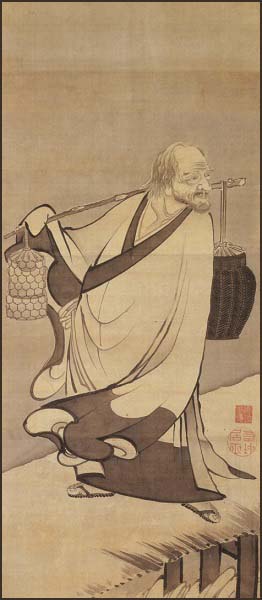Baisao: The First Tea Master, by Victoria Garafola
Image below: Painting of Baisao by Ito Jakuchu

Meet the Edo Period nomadic monk responsible for the popularization of Sencha. Baisao (売茶翁) went by several names over the course of his life. As a child he was Shibayama Kikusen. When he became a buddhist monk, he changed his name to Gekkai Gensho. As he grew older, he later rejected buddhism and changed his name once more to Ko Yugai. Over the course of his life, he traveled widely throughout Japan.
His most recognizable name, Baisao (売茶翁), literally means “old tea seller.” Baisao earned this name while traveling throughout Kyoto prefecture selling his uniquely prepared teas. When Baisao first began selling tea, he was still following his buddhist lifestyle. Perhaps for this reason, whenever charged a fixed price for his tea. Instead, he asked customers to pay what they could afford in the form of a donation.
Around the year 1735, he began to travel throughout Kyoto’s beautiful scenic countryside locations. During this time, he carried all his tea utensils in a bamboo basket that he had fastened to a stick he would sling over his shoulder. Baisao may have been one of the first individuals to prepare sencha style tea. During this time, powdered matcha tea was more popular and Baisao’s way of preparing tea was unusual. Baisao learned how to prepare loose leaf tea during his time in the monastery. Matcha ceremonies are quite rigid with many formalities. Sencha, on the other hand, appealed to the buddhist lifestyle due to it’s simplicity.
In addition to practicing buddhism and selling tea, Baisao was also a poet. In his poetry, he often utilized tea as a way to bring oneself closer to spiritual enlightenment.
By 1738, Baisao’s style of preparing tea had gained popularity and some farmers were experimenting with production methods. They began to steam and roll the young sencha leaves. This new way of handing the leaves after farming was different from the way things were done in China. The Japanese people loved the new method and began to refer to it as “sencha.”
Baisao resented the formality and stuffiness of traditional tea ceremonies. He spent much of his life renouncing the practice and encouraging to enjoy tea in a more relaxed fashion. By the time he reached 70 years old, he gave up his buddhist lifestyle. At 75, he decided to stop selling tea. At this point in his life, Baisao was quite famous. He realized his fame but also disliked the chanoyu practice of cherishing the tea accessories of masters. In one final act of defiance, Baisao burned his tea equipment so that his equipment would not be come relics.
Despite Baisao’s dislike of the idea of tea ceremony, a sencha tea ceremony arrangement was created based on his methods. One of his friends published illustrations of his utensils and craftsmen made copies of the tools. While these posthumous actions may have gone against Baisao’s personal belief system, it allowed people to continue creating tea the way Baisao would have. Ultimately, Baisao’s unconventional beliefs and his unique methods helped to facilitate the popularity of Japan’s favorite tea.





